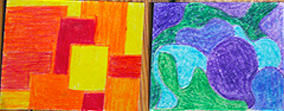Fourth Grade Art Lesson 2
Elements of Art, Part 1 Shape, Color and Space
Objective:
The student will know the warm and cool colors. The student will know that a shape is an area enclosed by a line and that there are two types of shapes, geometric and organic. The student will show space by overlapping shapes.
Materials:
several small cards or paper (index cards cut in half work well), crayons
Procedure:
Today we are going to begin looking at the seven elements of art. They are: line, shape, value, form, color, texture and space. These are the alphabet in art. We use the elements of art like you use the alphabet to write your name. We pick and chose from the letters available to us to spell the words we want to spell. Likewise, in art, we pick and chose the elements that will best help us create what we want to create. We are going to focus today on color, shape and space. I want you to become familiar with warm and cool colors. The warm colors are reds, yellows, and oranges. These can easily be remembered because they are the colors you find in the sun, which warms us up. The cool colors are the blues, greens and purples, which can be remembered by thinking of the ocean which we jump into to cool us off from the warm sun. When we look out over the ocean we see the greens, blues and purples. Next I want to talk about shape. Shape is an area enclosed by a line. Shapes are two dimensional. There are two kinds of shapes and they are geometric and organic. Geometric are shapes like circles, squares and rectangles. Organic are freeform shapes - shapes that do not necessarily have some kind of measurable quality. Finally, I want us to look at one aspect of space which is overlapping. Overlapping creates the illusion that one thing is in front and another is behind. There are many things we will learn about all three of these elements but this is enough information for one class. Now let's practice it. I want you to do two crayon drawings. One is a warm color geometric shape drawing with shapes that overlap. The other will be a cool organic shape drawing with shapes that overlap. Focus on using crayons by making sure your finished work is colored in solidly. If you use a single color you must press down firmly. If you mix colors, which I strongly encourage you to do, color lightly but layer the colors and as you build up each layer the color becomes more solid. Work with your crayons and find out the many great ways they can fill your work with color.
Conclusion:
Review all of the information we have learned today. What are the warm and cool colors? What is a shape? How do you define it? What are the two kinds of shapes? What is one way to show or create space? Look at your miniature works of art and check to see if you can pinpoint each of the art elements we discussed today and how they affect the way the finished product looks. Save these drawings to refer to later.
Artwork and Examples used in this lesson

Teacher Example













